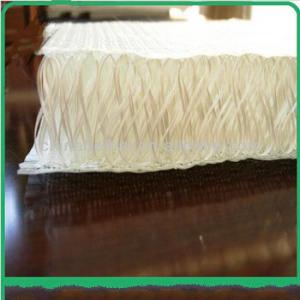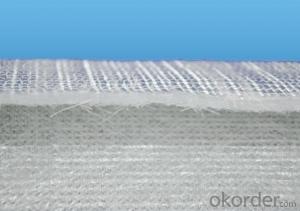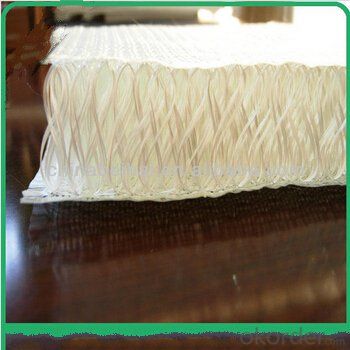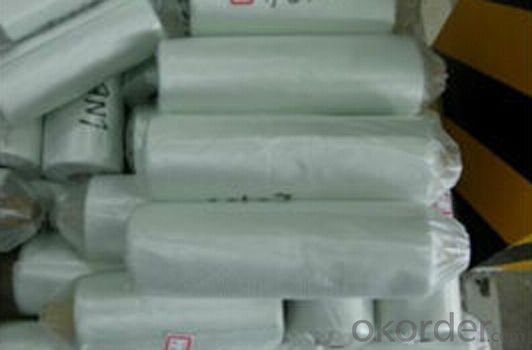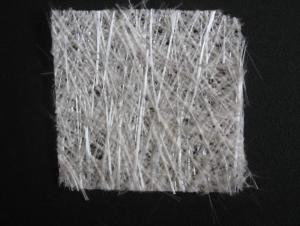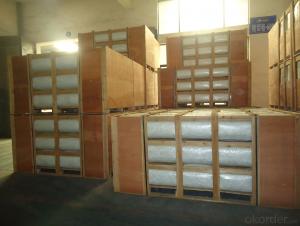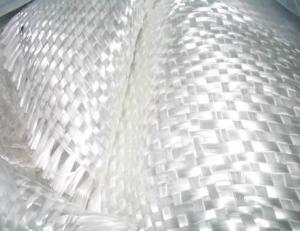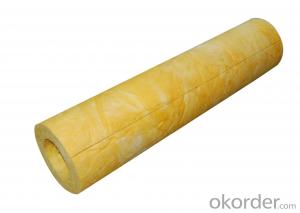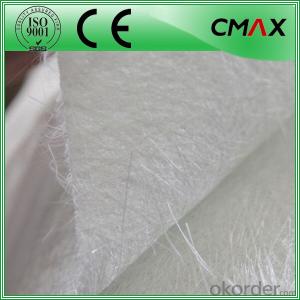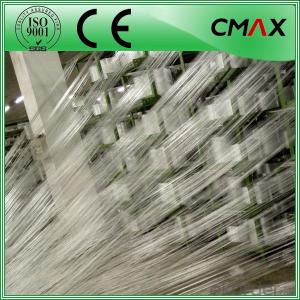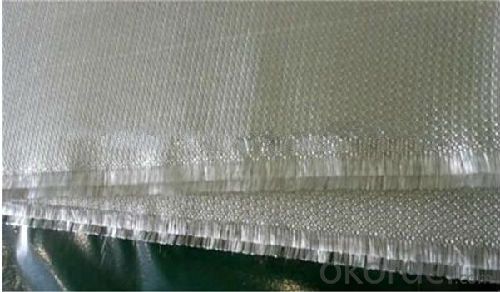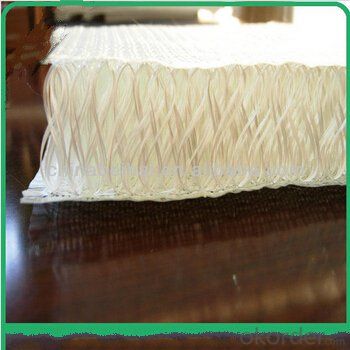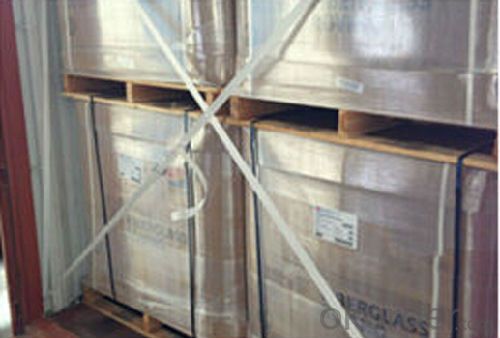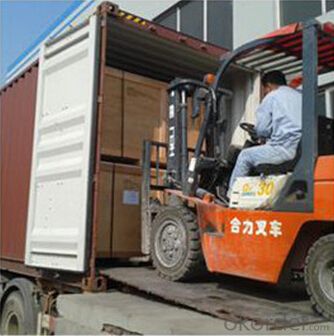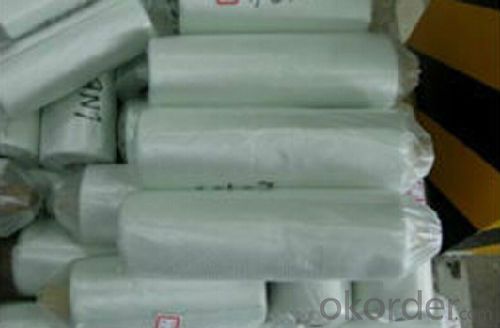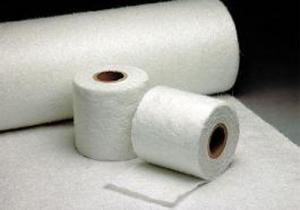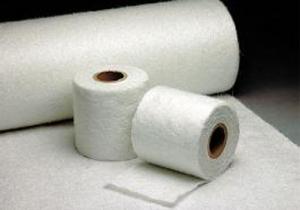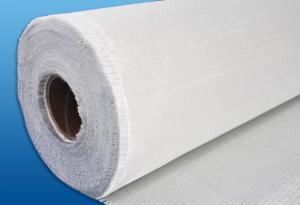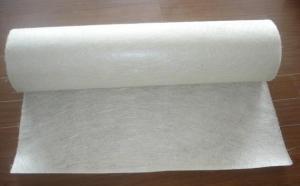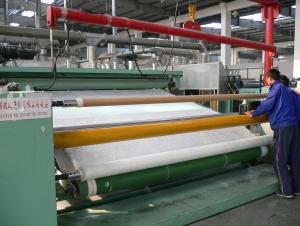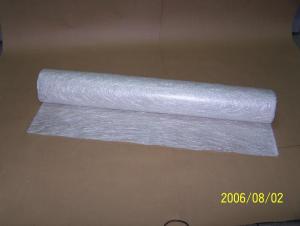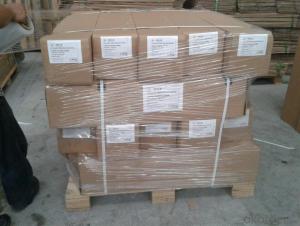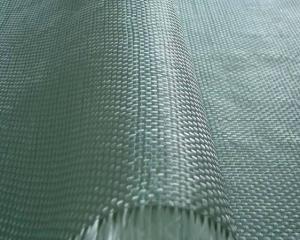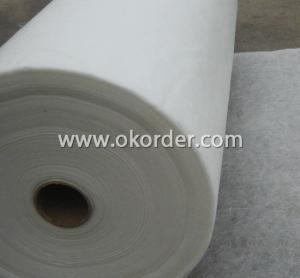Fiberglass Mat Tissue Sandwich Fabric Complex Mat 780g 200~2600 mm
OKorder Service Pledge
OKorder Financial Service
You Might Also Like
Description & application | |||||||||||||||||||||||||||||||||||||||||||||||||||||||||||||||
◎ This mat is the multi-layered combination mat, generally made by mechanically stitching layers of roving or woven roving or chopped strand, in this case to one or both sides of synthetic fiber core (PP or PET), like a sandwich. The complex mat generally also be made from a combination of woven roving which are mechanically stitched with mats made of chopped strand to form the “bread”. Some complex mat even have no roving or fabric (i.e. complexes stitched from mats and veils without fabric layers). In all cases, the layers are mechanically stitched to the synthetic fiber core. It is mainly applied in the hand lay up, RTM and other close molding processes. ◎3-D spacer fabric construction is a newly developed concept. The fabric surfaces are strongly connected to each other by the vertical pile fibers which are interwoven with the skins. Therefore, the 3-D spacer fabric can provide good skin-core debonding resistance, excellent durability and superior integrity. In addition, the interstitial space of the construction can be filled up with foams to provide synergistic support with vertical piles. These products have broad application prospects in automobile, Locomotives, aerospace, marine, windmills, building and other industries.
| |||||||||||||||||||||||||||||||||||||||||||||||||||||||||||||||
Products Traits | |||||||||||||||||||||||||||||||||||||||||||||||||||||||||||||||
◎ The structure of sandwich to increase strength, reduce product weight and better surface finish. | |||||||||||||||||||||||||||||||||||||||||||||||||||||||||||||||
| |||||||||||||||||||||||||||||||||||||||||||||||||||||||||||||||
| |||||||||||||||||||||||||||||||||||||||||||||||||||||||||||||||
| Application | |||||||||||||||||||||||||||||||||||||||||||||||||||||||||||||||
Marine Applications Structural: ·Bulkheads ·Decks ·Hulls of racing catamarans and ribs(RIBS) Non structural: ·Fly-bridges ·Cabins ·Hatches ·Doors Interior parts: ·Furniture ·Partitioning ·Floor and ceiling panels ·Sanitary Cabinets Wind Power Applications ·Nacelles Cover ·Nose cone ·Blade Chemical industry-Corrosion Applications · The following double wall structures can be obtained using 3D fabric ·Double wall full GRP Tank ·Double wall tank lining Building Applications ·Interior and exterior wall covers ·stone strengthen ·radar domes ·industrial roofing ·amusement parks ·exhibition panels ·kiosks ·lightweight rigid covers | |||||||||||||||||||||||||||||||||||||||||||||||||||||||||||||||
| |||||||||||||||||||||||||||||||||||||||||||||||||||||||||||||||
Each roll is wrapped by PE film and then packed into carton. Stacking in bulk or palletized is available; the pallet shall be no higher than 2 layers.
| |||||||||||||||||||||||||||||||||||||||||||||||||||||||||||||||
FAQ
Q: Can you accept sample order?
A: Yes, we accept samples with little and reasonable charge
Q: What is your MOQ?
A: Normally,4 rolls.
Q:How about your quality?
A: All of our products have obtained the GL and ISO9001 certificates ,Try a small order, you will have your judgements!
- Q: How does the fiber distribution of fiberglass mat tissue affect its strength?
- The strength of fiberglass mat tissue is significantly influenced by the distribution of its fibers. The primary source of strength for fiberglass mat tissue is the inclusion of fibers within the material. These fibers act as reinforcement and aid in evenly distributing stress and load across the surface. The distribution of fibers in fiberglass mat tissue refers to their arrangement and orientation within the material. When fibers are evenly distributed, with a consistent arrangement and orientation, the strength of the fiberglass mat tissue is enhanced. This uniform distribution allows for efficient transfer of load from one fiber to another, resulting in improved overall strength. Conversely, an uneven or random distribution of fibers, where they are clumped together or oriented in various directions, compromises the strength of the fiberglass mat tissue. This uneven distribution can create areas of concentrated stress, leading to weak points and potential failure under load. Additionally, the strength of fiberglass mat tissue is also influenced by the length and density of the fibers. Longer fibers provide greater reinforcement and enhance the tensile strength of the material. Furthermore, a higher fiber density, meaning more fibers per unit area, increases the overall strength and performance of the fiberglass mat tissue. In conclusion, the strength of fiberglass mat tissue is directly impacted by the distribution of its fibers. A uniform and evenly distributed arrangement of fibers improves the material's strength by facilitating efficient load transfer. Conversely, an uneven or random distribution compromises the strength by creating stress concentrations and weak points. The fiber length and density also contribute to the overall strength of the fiberglass mat tissue.
- Q: How does the density of fiberglass mat tissue affect its performance?
- The performance of fiberglass mat tissue is significantly impacted by its density. Fiberglass mat tissue finds its use in various applications such as insulation, construction materials, and composite materials. The strength, durability, flexibility, and thermal insulation properties of the fiberglass mat tissue are determined by its density. A higher density fiberglass mat tissue generally offers improved strength and durability. This is because a higher density means that more fiberglass strands are densely packed together, resulting in a denser and stronger material. It can withstand higher loads and impacts, making it suitable for applications that require structural integrity, like the construction or automotive industries. Furthermore, the flexibility of fiberglass mat tissue is also influenced by its density. A lower density fiberglass mat tissue tends to be more pliable and easier to shape. It can be molded into intricate shapes and contours, making it suitable for applications where flexibility is crucial, such as boat manufacturing or automotive body parts. The density of fiberglass mat tissue also affects its thermal insulation properties. Higher density fiberglass mat tissue provides better insulation against heat transfer. It effectively prevents the transfer of heat through conduction, making it ideal for insulation purposes in buildings or piping systems. However, it is important to consider that the choice of fiberglass mat tissue density should be based on the specific requirements of the application. While higher density may offer better strength and durability, it also increases the weight and cost of the material. Therefore, a balance needs to be achieved between the desired performance characteristics and the practicality of the specific application.
- Q: Is fiberglass mat tissue compatible with different resin systems?
- Yes, fiberglass mat tissue is compatible with different resin systems. It can be used with various types of resins such as polyester, epoxy, vinyl ester, and even thermoplastics. The fiberglass mat tissue acts as a reinforcement material that enhances the strength and durability of the final composite product when combined with different resin systems.
- Q: Can fiberglass mat tissue be used for repairing fiberglass boats?
- Yes, fiberglass mat tissue can be used for repairing fiberglass boats. Fiberglass mat tissue is a versatile material that is commonly used in repairing and reinforcing fiberglass structures, including boats. It is designed to provide strength and durability, making it an ideal choice for patching holes, cracks, or damaged areas in fiberglass boat hulls. The mat tissue is typically layered with resin to form a solid and stable repair, ensuring that the boat remains structurally sound. Additionally, fiberglass mat tissue is easy to work with and can be cut to the desired size and shape, making it suitable for various repair applications on fiberglass boats.
- Q: What is the expected lifespan of fiberglass mat tissue in underground applications?
- Different factors can affect the expected lifespan of fiberglass mat tissue in underground applications. These factors include the conditions of the underground environment, the quality and thickness of the fiberglass mat tissue, and the level of maintenance and care provided. On average, fiberglass mat tissue is known for its durability and longevity, which makes it suitable for use underground. Generally, fiberglass mat tissue is designed to resist corrosion, moisture, and other environmental elements commonly found in underground settings. This makes it a reliable choice for protecting underground pipes, tanks, and other infrastructure from deterioration. When installed correctly and maintained regularly, fiberglass mat tissue can last 50 years or more in underground applications. However, it is important to note that this estimate can vary depending on the specific conditions and usage of the fiberglass mat tissue. To maximize the lifespan of fiberglass mat tissue in underground applications, it is recommended to follow industry best practices. These practices include using proper installation techniques, conducting regular inspections, and promptly addressing any cracks or damage. By following these steps, the lifespan of fiberglass mat tissue can be extended, ensuring long-term reliability and durability underground.
- Q: How does fiberglass mat tissue perform in terms of moisture resistance?
- Fiberglass mat tissue performs excellently in terms of moisture resistance. Its dense structure and composition make it highly resistant to water absorption, preventing moisture from seeping through and causing damage to the underlying material. This property makes fiberglass mat tissue an ideal choice for various applications where moisture protection is crucial, such as in the construction of roofs, walls, and insulation.
- Q: How is fiberglass mat tissue used in the aerospace industry?
- Fiberglass mat tissue is extensively used in the aerospace industry due to its exceptional properties and versatility. It serves various purposes and plays a crucial role in the manufacturing and maintenance of aircraft. One of the primary applications of fiberglass mat tissue in the aerospace industry is its use in composite materials. Composite materials, which are made by combining two or more materials, are widely used in aircraft construction to reduce weight while maintaining structural integrity. Fiberglass mat tissue is often used as a reinforcement material in composite laminates. It provides strength, stiffness, and dimensional stability to the structure, making it suitable for various components such as wings, fuselage, and tail sections. The high tensile strength of fiberglass mat tissue ensures the composite structure can withstand the demanding conditions faced in the aerospace industry. Furthermore, fiberglass mat tissue is also utilized in the repair and maintenance of aircraft. It is commonly used in the process of composite patching, which involves repairing damaged or worn-out composite components. The fiberglass mat tissue is impregnated with resin and applied to the damaged area, providing strength and restoring structural integrity. This technique is widely employed for repairing aircraft components such as fairings, radomes, and other composite parts, ensuring their safe and reliable operation. Moreover, fiberglass mat tissue finds application in the insulation of aircraft. It is used as a thermal and acoustic insulation material in the interior cabin and other critical areas of the aircraft. Fiberglass mat tissue helps in reducing heat transfer, preventing condensation, and maintaining a comfortable cabin environment for passengers and crew. Additionally, its sound-absorbing properties help minimize noise levels inside the aircraft, enhancing the overall travel experience. In conclusion, fiberglass mat tissue is an indispensable material in the aerospace industry. It is used in the production of composite structures, repair and maintenance of aircraft, and as an insulation material. Its exceptional properties, including high tensile strength, dimensional stability, and thermal/acoustic insulation capabilities, make it an ideal choice for various applications in the aerospace industry.
- Q: What are the typical mechanical properties of fiberglass mat tissue?
- The typical mechanical properties of fiberglass mat tissue include high strength, excellent tensile and tear resistance, good dimensional stability, and low elongation. Additionally, it has a high modulus of elasticity and is resistant to corrosion, chemicals, and moisture.
- Q: Can fiberglass mat tissue be used for making lightweight flooring?
- Yes, fiberglass mat tissue can be used for making lightweight flooring. Fiberglass mat tissue is a material that is commonly used in construction and manufacturing industries for its strength, durability, and lightweight properties. It is made by bonding fine fiberglass strands together with a binder, which results in a thin, flexible, and lightweight material. When used in flooring applications, fiberglass mat tissue can provide several advantages. Firstly, its lightweight nature makes it easier to handle and install, reducing the overall weight of the flooring system. This can be particularly beneficial in applications where weight is a concern, such as in aircraft or mobile homes. Additionally, fiberglass mat tissue is known for its excellent strength-to-weight ratio, making it a suitable material for creating lightweight yet strong flooring. It can provide reinforcement and improve the structural integrity of the flooring, making it more resistant to cracking, warping, or other forms of damage. Furthermore, fiberglass mat tissue is resistant to moisture, chemicals, and fire, making it a suitable choice for areas where these factors are present, such as bathrooms, kitchens, or industrial settings. It also offers good insulation properties, which can help in maintaining a comfortable indoor environment and reducing energy consumption. Overall, fiberglass mat tissue can be an excellent choice for making lightweight flooring due to its strength, durability, moisture resistance, and insulation properties. However, it is important to consider other factors such as the specific requirements of the flooring application, the load-bearing capacity, and the necessary certifications or standards before finalizing the use of fiberglass mat tissue in a flooring project.
- Q: Is fiberglass mat tissue resistant to chemicals?
- Generally, fiberglass mat tissue is resistant to chemicals. Its composition, comprising fine glass fibers bonded together with a resin, grants it exceptional chemical resistance properties. This resistance enables the fiberglass mat tissue to endure exposure to various chemicals without deteriorating or compromising its structural integrity. Nevertheless, it is crucial to acknowledge that the precise chemical resistance of fiberglass mat tissue may differ based on the type and concentration of the chemical it encounters. Therefore, it is advisable to consult the manufacturer's guidelines or perform suitable testing to ensure compatibility with particular chemicals.
Send your message to us
Fiberglass Mat Tissue Sandwich Fabric Complex Mat 780g 200~2600 mm
OKorder Service Pledge
OKorder Financial Service
Similar products
Hot products
Hot Searches
Related keywords
